This is it: everything you need to know about the locally-driven community solar model that’s bringing clean energy to millions of Americans for the first time.
After over 100 years of fossil fuel emissions from distant power plants, Americans are taking control of their energy. They want it to be more local, more affordable, more resistant to outages, and more sustainable for the next generation. In a word, they want a say in the present and future of their community. So they’re turning to community solar.
If you’re not a community solar expert right now, no worries. This guide will outline what it is, how it works, and how every American—that’s right, everyone—stands to benefit.
If you’re already familiar with community solar, consider this guide a central resource for best practices and answers to the most common questions. And if you have additions or suggestions, please let us know in the comments!
Either way, I make two promises to you:
- First, this guide will be thorough; no skipping important subjects.
- Second, unlike a lot of the stuff you read about energy, this guide will be simple and readable. Power doesn’t need to be full of jargon. Nobody likes jargon.
In 15 minutes, you’ll understand how you and your neighbors can grab the reins on your energy future.
Here’s what you’ll learn in this guide to community solar (feel free to hop around to whatever captures your attention):
Table of Contents
Why Community Solar?
Issue #1: Shifting temperatures and brutal storms are changing people’s lives right now. Daily evidence of a changing climate is piling up, and the masses are finally starting to take action. 2019 surveys show that more Americans are worried about climate change (and want to fix it) than ever before.
That’s where renewables come in. Emissions-free energy eliminates the nasty chemicals and greenhouse gases that change our climate and make us sick. Clean energy is the key to a sustainable planet for our kids, our kids’ kids, and those of us that aren’t ready to think about kids but still plan to live long, happy lives.
But as much as we like to gather around and sing our praises to clean energy, there’s another problem.
Issue #2: Most people can’t get clean energy. Not because it doesn’t work well enough (it does) or you can’t store it (you can) or it isn’t hip or mainstream enough (it’s actually quite trendy), but because payments for most clean energy sources haven’t become appealing to most people.
Even though solar and wind costs have fallen dramatically (below those of existing coal plants, by the way), fewer than one quarter of Americans can actually put solar on their roof. A pretty small group of lucky unicorns can claim they meet all the criteria. What ends up happening, then, is that rooftop solar thrives in certain communities, but thoroughly fails to enter others.
And while wind turbines and hydroelectric plants are making a huge difference nationally and globally, they’re not everyday solutions for individuals or communities that want to enact change. Not at this moment, anyway.

We end up with millions of Americans who want more clean energy but feel like that’s a distant technology meant for big businesses and rich folks with the time and capital to worry about and finance such things.
Most people can’t afford to spend more on electricity right now, even if it means they’ll spend less later. That’s a nice segue into the next issue:
Issue #3: American electricity prices have risen by about 25% since 2000. 25 million American households report they’ve skipped spending on food and medicine to pay their electric bills.
This is an incredibly important statistic that isn’t talked about enough. Energy is so essential to everyday life that Americans are literally prioritizing it over taking care of their bodies.
I think we can all agree they shouldn’t have to make that choice.
Compounding this issue is the fact that the first issue, increasing storm severity, is disrupting electricity delivery and damaging infrastructure. These things are making electricity less reliable and more expensive.
So we need clean energy for everyone. We need it to work for the mansions and corporations that emit the most, but we also need it for the folks who struggle every month to pay their bills. We’re never going to mitigate climate change or realize the full economic benefits of renewables until we get everyone involved.
That’s why community solar exists: to finally deliver on the promises of solar energy to the millions and millions of people that stand to gain from lower bills and cleaner air. If community solar spreads at the rate it’s going now, it won’t be long before we eradicate the phrase, “I can’t afford to go solar.”
Want the complete guide in PDF form?
How Community Solar Works
Community solar allows community members to join in on an array of shared solar panels. You, your friend, and your coworkers can all become a part of a single local solar garden bringing clean energy to your neighborhood. Without changing your own property or paying anything upfront, you’ve both “gone green” and “saved green.”
Creating the jobs and raising the money to bring clean energy to entire communities, while keeping it so affordable that anyone can participate…that has to be complex, right?
It’s actually delightfully, beautifully, simple.
At its core, community solar is a three-step process.
- In step one, a developer builds a solar garden that serves a local community. The garden produces energy and sends it off to the grid. Sun –> solar panels –> energy. Boom.
- The electrons from the solar garden get mixed up with all the other electrons from all the power plants feeding into the grid.
- Energy goes straight to the homes of local community members like always, but it’s cleaner, cheaper (for those who signed up for the solar garden), and more local.
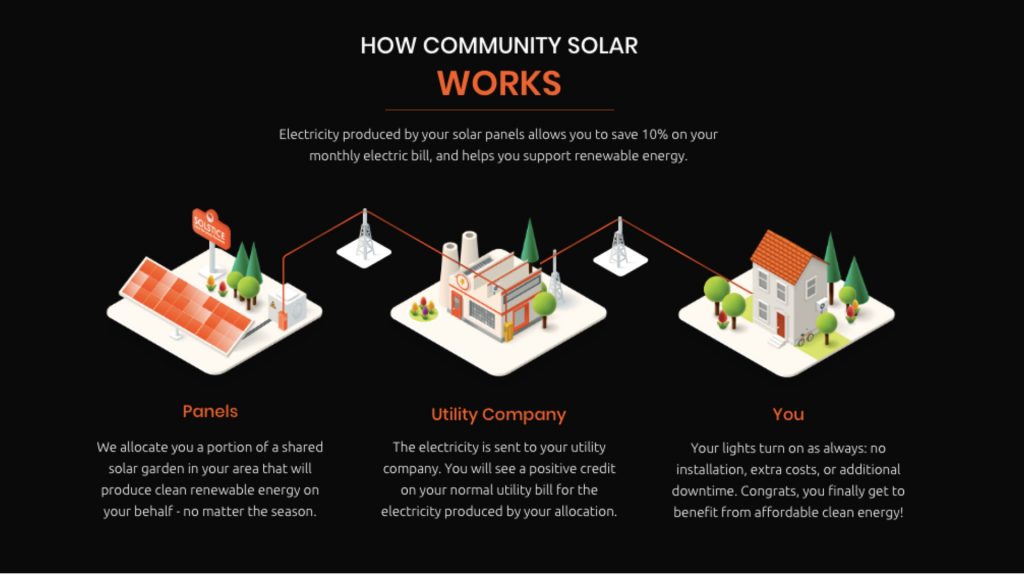
Did that bit about signing up for the solar garden catch your eye? Here’s how customers fit in.
How It Works For the Customer
We often think of companies as groups that create a product and then find customers to sell it to. But smart companies make sure they’ll have customers first so they don’t waste time and money creating a product no one really wants. Solar developers and the investors that fund community solar projects are no different. They need to see that local people are excited to sign up for community solar before they commit to building a project. Utility payments from customers that sign up go toward paying back those people. So without customers, there’s no future revenue stream and no solar gardens.
Let’s say Joe Smith, a recently-retired businessman, learns that a solar garden is being built near his home. Joe’s a savvy guy who wants to make the most of his savings. He also thinks of himself as a responsible citizen—someone who wants to set his family and neighborhood up for success in the long run. So he signs up.
When Joe signs up, he’ll get allocated a share of the solar garden proportionate to his energy use. Depending on how much energy he used last year, he might get three panels, four, or however many he needs to offset the electricity he uses annually at his home. Technically, allocations are measured in kilowatts, not panels, since that’s more nuanced—but you get the idea.
In a perfect world, Joe’s allocation perfectly offsets his electricity use every month. This doesn’t always happen, so we’ll come back to that in a couple of paragraphs. But for now, we’ll assume perfection because it’s simpler. By offsetting his energy use, Joe will no longer have to pay for dirty energy; he’ll only pay for the energy his solar panels produce. But here’s the kicker: he pays less on a yearly basis than he would have otherwise. Falling clean energy prices and government incentives make solar power cheaper than traditional energy. And because Joe doesn’t have to install anything or maintain the panels, he pays no upfront or ongoing fees. He just reaps the benefits every month of cheaper, cleaner energy.
How much less he pays depends on the particular solar garden for which he signs up. Like any product, different developers make unique offers to their customers. Here are a couple of common models:
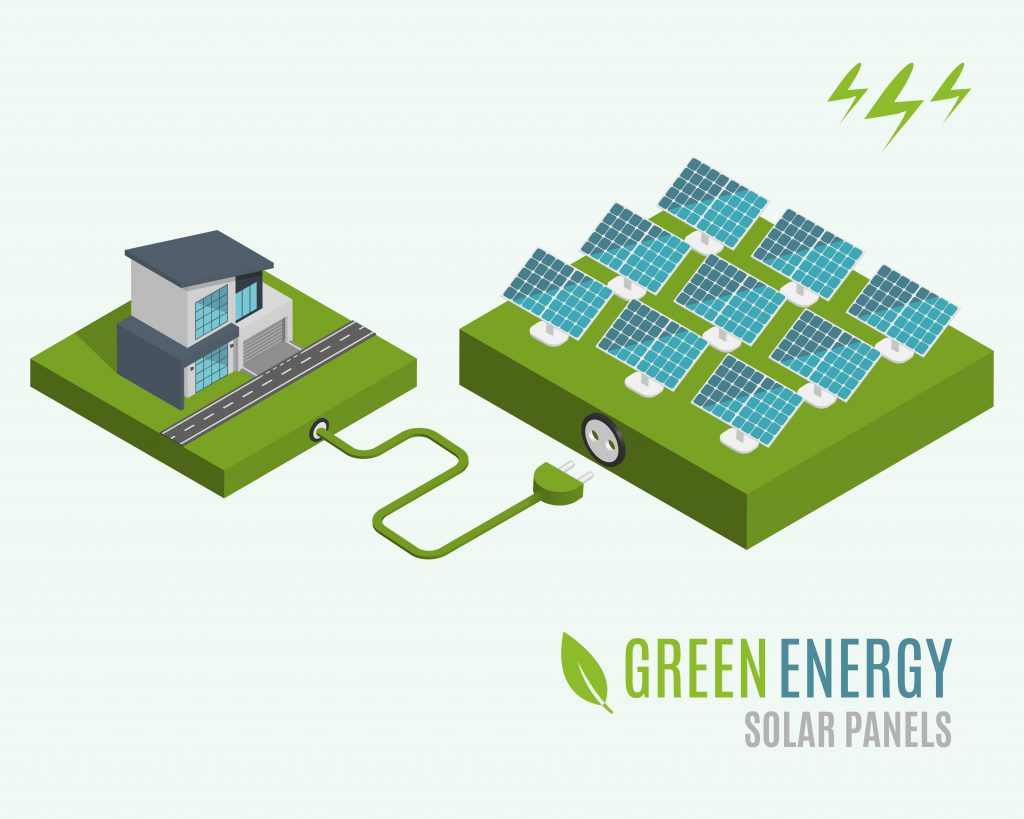
Solar gardens allow your household to “plug in” to clean energy.
Fixed Discount Rate
Community solar can give customers a set discount rate (often 10%) on their monthly utility bills. In this case, if Joe’s April electric bill is $100 and his bill is offset by the solar garden, then he’ll get $100 in credits on his utility bill from his solar panels. He’ll receive a $0 bill from his utility, then separately he’ll get a $90 bill from the solar garden since he pays for the energy his solar panels produce at a 10% discount.
Fixed Electricity Price
Another popular plan is to lock in a fixed electricity price—often the price it stands at today or, sometimes, an even lower rate—for the life of the contract. That might not sound as thrilling as a direct 10% discount, but don’t forget: energy prices are rising across the country, with no signs of slowing down. If that rate continues, Joe will save more in the long run on a low fixed price plan than he will with a fixed 10% discount rate.
For example, we’re signing up New York residents right now in the counties of Orange and Rockland for a community solar garden that locks in their electricity price below current utility rates. It’ll stay there for the length of their participation in community solar, so when their friends’ bills go up (as they tend to do, at a rate of almost 1% a year), community solar customers’ bills won’t.
A look at construction on a recently-completed solar garden in New York
When Allocations Don’t Perfectly Offset Energy Use
Joe’s solar panels will offset his energy use for the year, but they won’t do so perfectly every month. That’s because Joe’s energy use will naturally vary from month to month, and so will the amount of energy his panels create. Conveniently, his panels are most productive during the summer when he’s also probably using the most electricity. But on a given month, Joe’s panels might produce more or less electricity than he actually needs. We’ll use our April example from above to explain what happens.
If his panels overproduce, he’ll still get the $100 credit for April, and extra credits will roll over into the next month. This makes summer and fall especially fun as a community solar customer.
If his panels underproduce, he may not offset all $100. Instead, let’s say he gets $95 in solar credits. In this case, Joe will pay $5 to his utility, and he’ll pay separately for $95 of solar credits at the fixed discount or price that he agreed to in his contract. In a 10% discount model, he’ll end up paying $85.50 for those credits, giving his bill a grand total of $90.50 instead of the $100 he would have paid without community solar. Shortages during one month get made up for by rollovers in other months.
Benefits of Community Solar
We’ve touched on some of these already, but if you’re still wondering why I’m yapping about community solar so much, here is a list, curated from this blog post:
- It brings clean energy’s environmental impacts to scale
- It reliably saves people money on electricity
- It doesn’t involve installations on people’s homes
- It localizes energy control and improves national energy independence
- It gives individuals a voice and a platform to take action for a better future
If you’re into the idea of building a cleaner planet, know that an average American household offsets about 5 tons of CO2 per year by going solar.
If you want to send the message that people need access to locally generated, reliable energy, you can do that.
If you like having more money, even if you’re not so invested in the two items I listed above, community solar literally gives you more money. Hard to argue with that.
These benefits explain why the community solar market is exploding with growth right now and gaining ground on other renewable energy sources. A few states in particular have really taken the lead, but new states have seen the advantages in the past few years. Most states now either have community solar in place or have started pilot programs to make it happen.
Where To Find Solar Gardens
The press usually pays more attention to solar farms than solar gardens. The difference between the two is about what you’d expect: solar farms are typically big projects, sometimes hundreds or thousands of acres, that produce massive amounts of clean energy. A single solar farm can offset emissions from tens of thousands of homes. And, if I do say so myself, they can be quite beautiful.
Solar gardens, on the other hand, are usually smaller. Think of solar gardens as community gardens for solar energy. Just like community gardens give you locally grown food whose roots you can trust, solar gardens replace dirty, far-out power plants with a local energy source everyone can rally around. They typically serve a few hundred to a few thousand nearby households, while bringing jobs and tax revenue to the towns where they’re built. The Laurens solar garden, shown in the earlier video, was 13 acres in size.
Between you and me: most people use solar farm and solar garden interchangeably, and that’s all right. They both work.
No matter how you slice it, solar gardens take up space, so it’s crucial to make sure we build them in the right places so as not to use up land that could be used in other valuable ways. After all, community solar projects are specifically designed to bring benefits to their local communities. Placing solar gardens on previously unused or unusable land (such as brownfields, capped landfills, or hazardous waste sites) increases your town’s revenue without sacrificing other opportunities to use space.
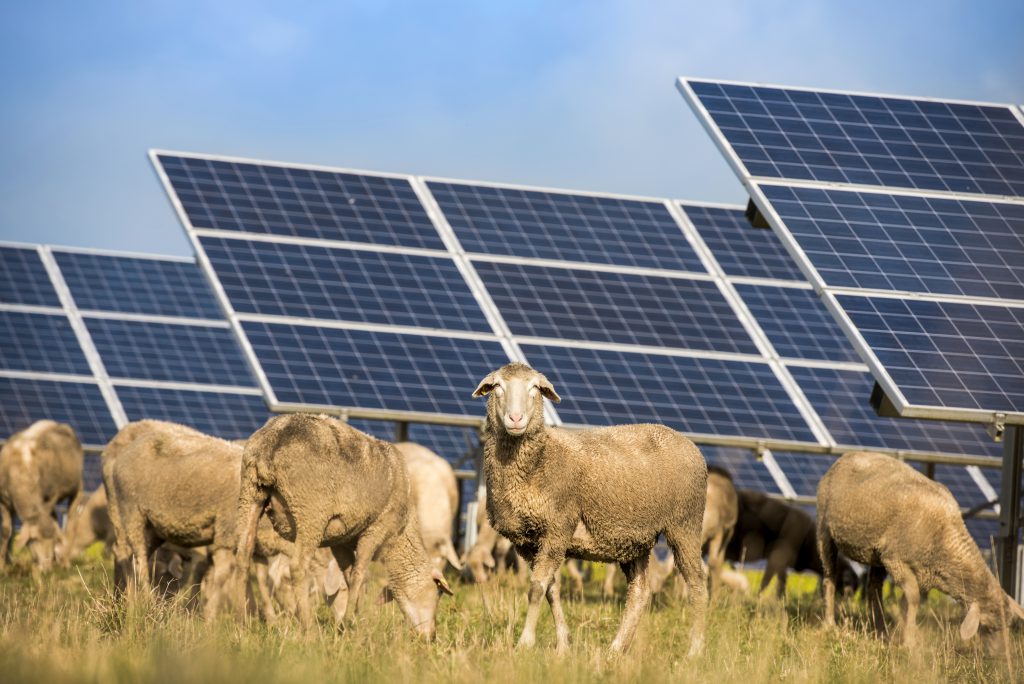
Solar gardens can also be built on farmlands. This becomes a little controversial, since some people worry solar panels will cut into their food supply and/or hurt local farmers. Concerns like these are fair, and they’re critical in keeping developers honest and ensuring the proper use of local lands. The reality, though, is that farmlands are perfect for solar–large, flat, and unshaded–and solar gardens present no risk to our food supply. Farmers can use community solar gardens as a steady stream of revenue and as a way to keep their land safe from other, less eco-friendly development. At the same time, they give their neighbors an opportunity to subscribe and save money on energy. And on top of all that, evidence shows that solar gardens can be a great home to wildlife, from sheep to bees to a variety of plants. The movement for agrivoltaics–sharing land between farming and solar–has gained serious traction.
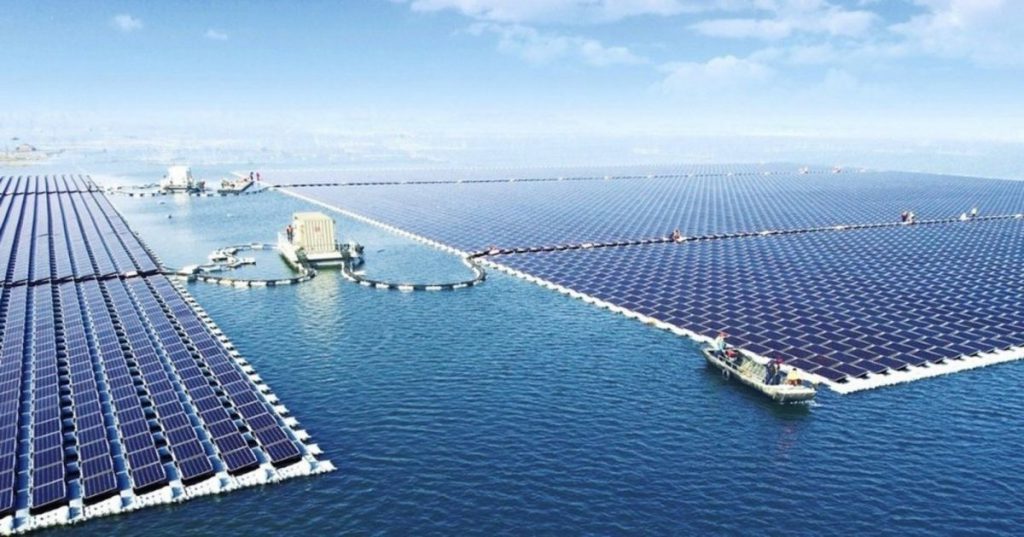
Image credit: Sungrow
Floatovoltaics (solar farms built on top of bodies of water, ideally already-contaminated water to minimize effects on wildlife) are also joining the party. They’ve become a hit in China, and are popping up in other countries, including the United States. To be clear: we’re not short on land space for solar gardens. We’d only need to use a tiny portion of America’s land on solar panels to power the whole country, or even the entire world. But floating solar farms are also objectively fun—as long as you can find installers that are also good swimmers!
Community solar projects aren’t always well advertised. As a result, a lot of eager customers that would happily sign up miss out on the chance. Solstice is in the process right now of compiling the nation’s solar gardens into one convenient online database so that you can surf around and find options in your area. Subscribe to our bi-weekly email updates to get notified when the database is up and running!
Want the complete guide in PDF form? Get it for free.
Who Is Eligible For Community Solar?
This is the fun part where I get to tell that if you reliably pay your electric bill, you can be eligible for community solar. Finally, clean energy for all. You, your spouse, your kids, your mother, your dog…okay, your dog can’t sign up. But here are some examples of people who can:
- Renters can subscribe to community solar. Thought you had to watch from the sidelines because you didn’t own your home? Think again. This world is yours, and so is your utility bill. Grab the reins.
- Landlords who pay electric bills can sign up for community solar and enjoy savings on every single meter they cover. Not half bad.
- Businesses can go solar even if they don’t own their building or have a suitable roof. The savvy lady that brings up community solar to her company can often earn referral credits for everyone that signs up—not to mention that kudos she’ll get from coworkers saving money due to her great idea.
- Homeowners and condo owners are eligible, too, just like rooftop solar and other energy efficiency and clean energy projects.
The invention of the EnergyScore is set to remove credit score requirements from community solar altogether, broadening access to Americans with low credit but who still consistently pay their electric bills. So stop telling yourself that clean energy is too far-fetched for you. Starting now, it isn’t!
Over To You
We hope you’ve learned a thing or two from this guide. As mentioned at the beginning, feel free to let us know what you think in the comments. We’re always looking for new perspectives and opinions on community solar—we’re kind of nerds like that.
We’ve also created a handy PDF that gathers all the key information on solar gardens for you. If you’re like me and don’t like finding a website every time you want a good read, take it with you! It just might help you join the clean energy revolution.
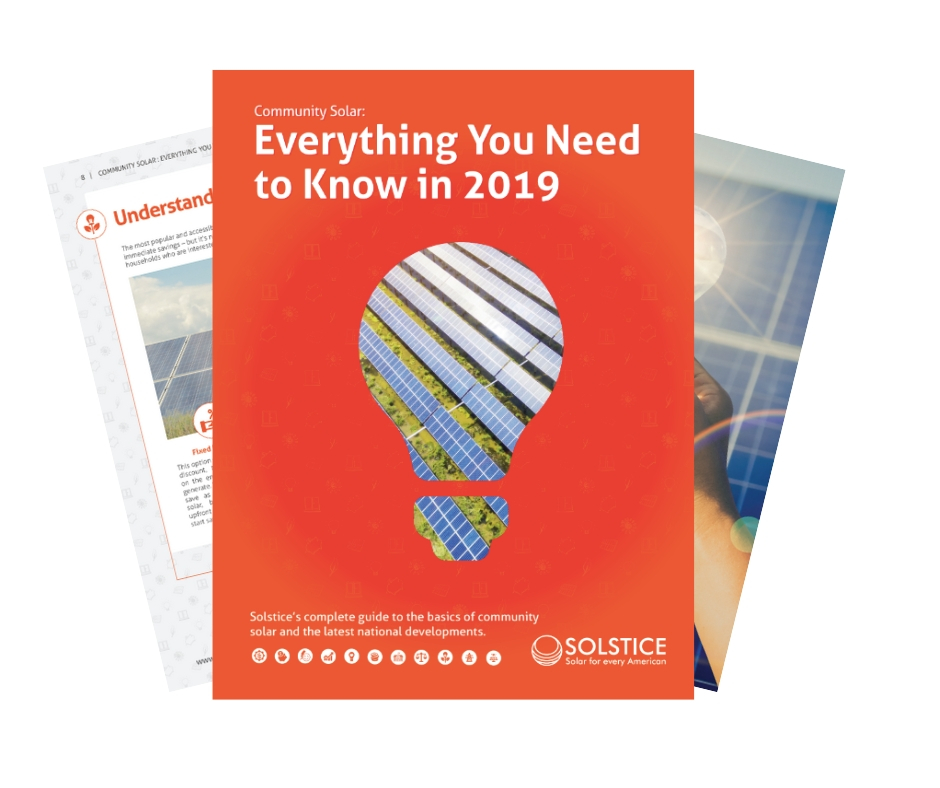
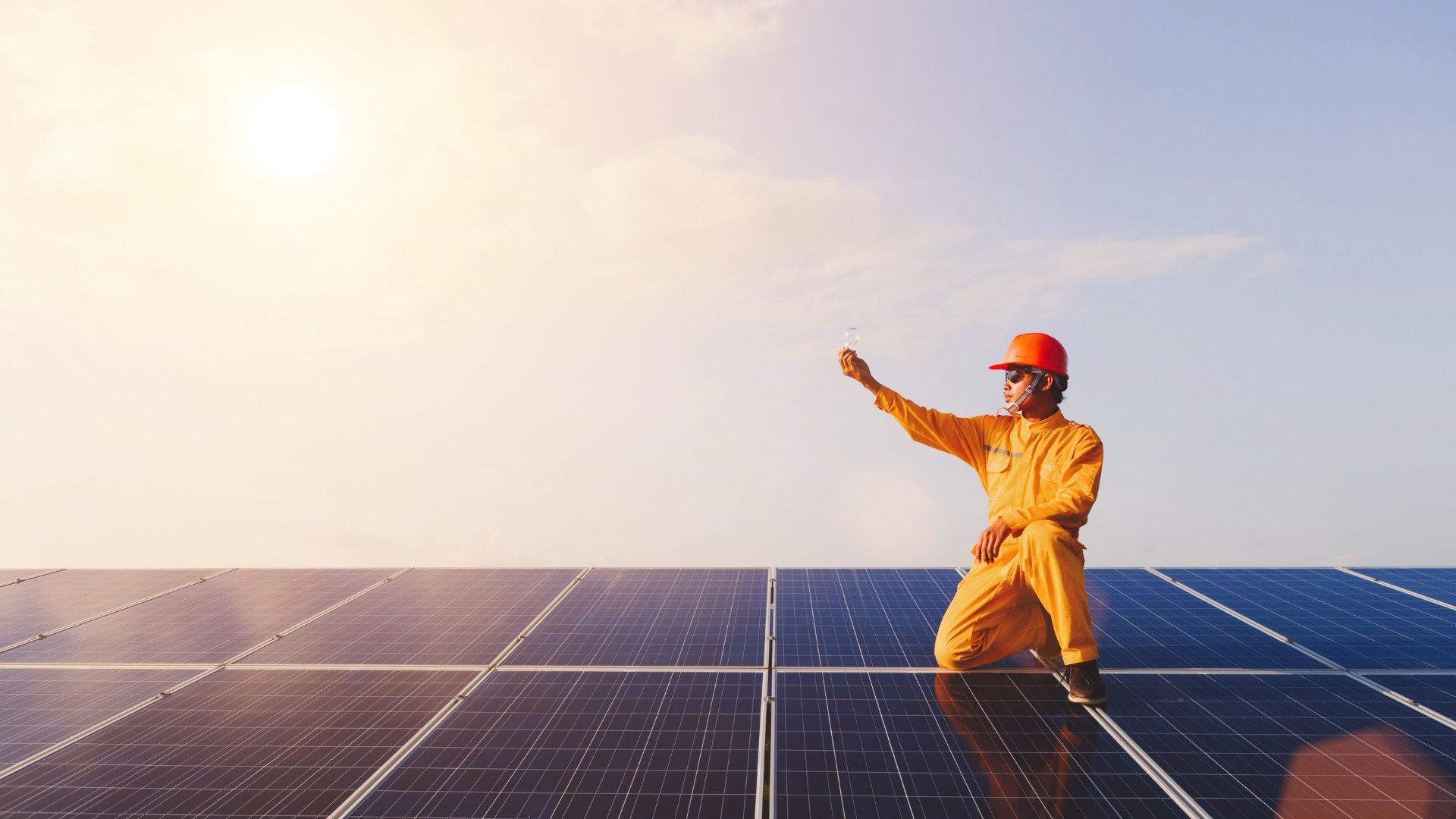
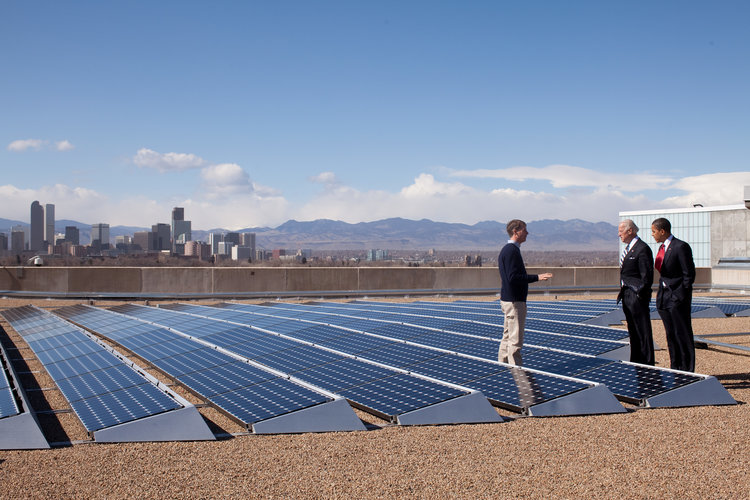
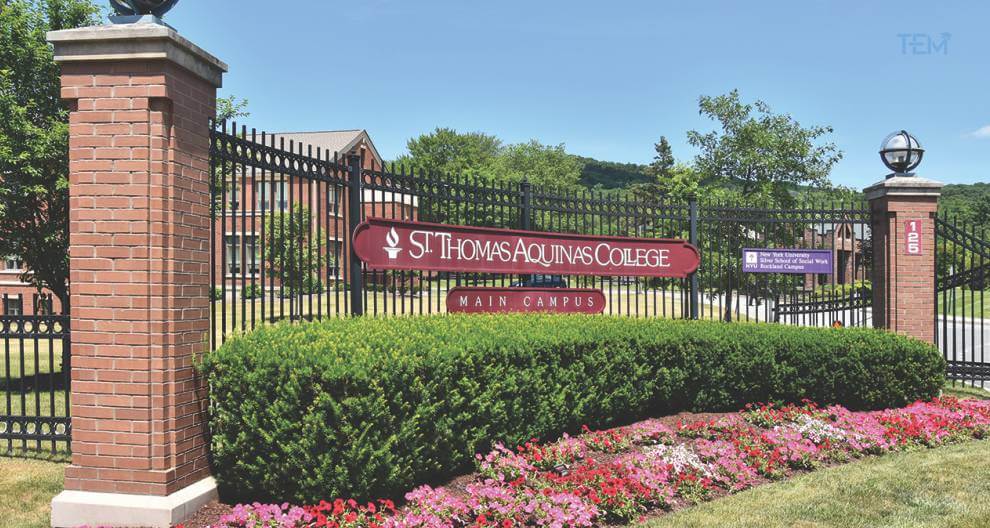
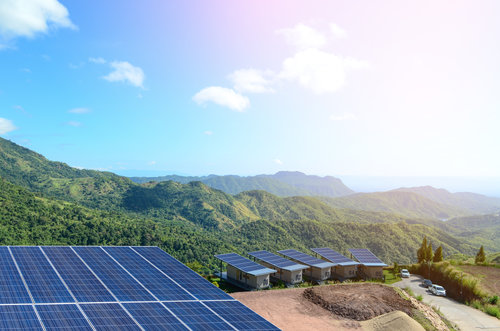

This website is awesome.This helped me with saving energy in your home it was very informative. I like the fact that are so many ways of saving energy. thank you for creating this article.
I have been planning to install a solar power system on my house's roof because I heard that it can help reduce my electricity bill. I agree with you that energy is so important that most of us prioritize this more than our other needs. It's also frustrating to learn that, some people can't get clean energy.
Solar for Africa. I read through the article and I am convinced that we can come up with solar farm or solar garden to help solve electricity problems in this region. I will be willing to work with you on this having conceived the idea of a solar farm recently. Thanks
Hey Ajayi, thanks for the comment! I see you got in touch with our team earlier, and hope you get some helpful information for pursuing community solar in your region! We don't currently work outside of the U.S., but have seen the power that distributed solar can have in electrifying communities. In fact, seeing micro grids work in India was actually what inspired our Co-Founder and CEO to start Solstice. Best of luck to you, and stay in touch!